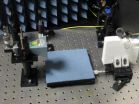(Press-News.org) Compared with humans, computers have the capacity to solve problems at much greater speed. There are many problems, however, where computational speed alone is insufficient to find a correct or optimal solution, for example because the parameter "space" cannot be fully searched in a practical time. In contrast, the human mind can formulate expert knowledge specific for particular problems, providing a capacity to guide more efficient searches, although with more limited processing speed.
The power of the human contribution can be multiplied through the efforts of a greater number of individuals. The term `crowdsourcing', which combines the two domains of human and electronic computing, was coined in 2006 and since then has seen its definition broadened to a wide range of activities involving a network of people.
A challenging problem that might benefit from crowdsourcing is the phase problem in X-ray crystallography. Retrieving the phase information has plagued many scientists for decades when trying to determine the crystal structure of a sample.
In a diffraction experiment, the observed diffraction pattern allows measurement of the amplitudes of the reflection structure factors (as the square root of the intensities) but not their phases. The amplitudes and phases are both needed to reconstruct an electron-density map (by Fourier synthesis) so that a model of the crystallized molecule can be obtained.
There are a number of ways currently scientists try to solve the phase problem, all with varying degrees of success.
Regardless of the particular approach, most attacks on the phase problem can be viewed as having two sub-problems. One concerns how a high-dimensional space (i.e. of phases) can be efficiently searched, while the other concerns how a good solution can be recognized.
Crowdsourcing may be a route to solving these sub-problems [Jorda et al. (2014), Acta Cryst. D70, 1538-1548; doi:10.1107/S1399004714006427 ], here scientists have developed a game based on a genetic algorithm (a powerful search-optimization technique), where players control the selection mechanism during the evolutionary process (by recognising the good solutions). The algorithm starts from a population of "individuals", in this case a map prepared from a random set of phases, and tries to cause the population to evolve towards individuals with better phases based on Darwinian survival of the fittest. Players apply their pattern-recognition capabilities to evaluate the electron-density maps generated from these sets of phases and to select the fittest individuals.
The game called CrowdPhase was applied to two synthetic low-resolution phasing puzzles and it was shown that players could successfully obtain phase sets in the 30 degree phase error range and corresponding molecular envelopes showing agreement with the low-resolution models.
Successful preliminary studies suggest that with further development the crowdsourcing approach could fill a gap in current crystallographic methods by making it possible to extract meaningful information in cases where limited resolution might otherwise prevent initial phasing.
INFORMATION:
Crowdsourcing the phase problem
2014-06-17
ELSE PRESS RELEASES FROM THIS DATE:
Genetic pathway can slow spread of ovarian cancer
2014-06-17
University of Adelaide research into the origins of ovarian cancer has led to the discovery of a genetic pathway that could slow the spread of the cancer.
The discovery is in part due to research into the genetics of humans' most distant mammalian relative, the platypus.
In a paper published today in the journal PLOS ONE, researchers characterize a genetic pathway – involving piRNA genes – that is turned on in ovarian cancer.
"This pathway is important for the development of the ovaries in drosophila flies but little is known about its role in the mammalian ovary," ...
NIST technique could make sub-wavelength images at radio frequencies
2014-06-17
Imaging and mapping of electric fields at radio frequencies (RF)* currently requires the use of metallic structures such as dipoles, probes and reference antennas. To make such measurements efficiently, the size of these structures needs to be on the order of the wavelength of the RF fields to be mapped. This poses practical limitations on the smallest features that can be measured.
New theoretical and experimental work by researchers at the National Institute of Standards and Technology (NIST) and the University of Michigan suggests an innovative method to overcome ...
Overweight + gene mutation = elevated liver values in children
2014-06-17
A study carried out at the Institute of Biomedicine of the University of Eastern Finland shows that a common mutation in the PNPLA3 gene combined with overweight results in elevated ALAT values in children. The ALAT value is an indicator of liver metabolism. In adults, this gene mutation is known to promote the accumulation of fat in the liver. The new results indicate that a healthy lifestyle is important already in childhood in order to prevent the accumulation of fat in the liver, and it is especially important for those carrying the risk gene. The results will be published ...
Brazilian surgeons review experience with soccer-related facial fractures for PRS-GO
2014-06-17
June 17,2014- Fractures of the nose and other facial bones are a relatively common and potentially serious injury in soccer players, reports a Brazilian study in Plastic and Reconstructive Surgery—Global Open® , the official open-access medical journal of the American Society of Plastic Surgeons (ASPS).
On the eve of the 2014 World Cup, a group of Brazilian plastic surgeons review their experience with soccer-related facial fractures requiring surgery. Dr. Dov Charles Goldenberg, MD, PhD, of University of São Paulo and colleagues write, "Due to exposure and the lack ...
Surfing the Web in class? Bad idea
2014-06-17
EAST LANSING, Mich. — Even the smartest college students suffer academically when they use the Internet in class for non-academic purposes, finds new research by Michigan State University scholars.
The study, funded by the National Science Foundation, speaks to typical lecture-hall culture in which professors compete for students' attention with laptops and smartphones.
"Students of all intellectual abilities should be responsible for not letting themselves be distracted by use of the Internet," said Susan Ravizza, associate professor of psychology and lead investigator ...
MIPT-based researcher predicts new state of matter
2014-06-17
A researcher with the Department of Electrodynamics of Complex Systems and Nanophotonics, Alexander Rozhkov, has presented theoretical calculations which indicate the possible existence of fermionic matter in apreviously unknown state – in the form ofaone-dimensional liquid, which cannot be described within the framework of existing models. Details are contained in Rozhkov's article in the journal Physical Review Letters, and are also available as a preprint at http://www.arxiv.org.
Rozhkov explained that the one-dimensional liquid state of matter is not necessarily one ...
Early elementary school start times tougher on economically advantaged children, study finds
2014-06-17
WASHINGTON - Middle- and upper-class elementary school students in Kentucky demonstrated worse academic performance when they were required to start classes early, compared to peers whose school day started later, according to research published by the American Psychological Association.
Researchers led by Peggy S. Keller, PhD, of the University of Kentucky, theorized that earlier school start times would be associated with lower standardized test scores, poorer attendance, more students being left back, lower school rank and school underperformance. They also expected ...
Researchers identify mechanism that could help old muscle grow
2014-06-17
[Boston, MA June 17, 2014]─ Sarcopenia – the significant loss of muscle mass and function that can occur as we age – is associated with many chronic conditions such as diabetes, high cholesterol and obesity. In findings published online ahead of publication in the September 2014 issue of the FASEB Journal, researchers at the Jean Mayer USDA Human Nutrition Research Center on Aging at Tufts University identify a muscle-building mechanism that could be important in addressing sarcopenia.
When people strength train the body responds by making muscle. The researchers ...
Hearing protein required to convert sound into brain signals
2014-06-17
HEIDELBERG, 17 June 2014 – A specific protein found in the bridge-like structures that make up part of the auditory machinery of the inner ear is essential for hearing. The absence of this protein or impairment of the gene that codes for this protein leads to profound deafness in mice and humans, respectively, reports a team of researchers in the journal EMBO Molecular Medicine.
"The goal of our study was to identify which isoform of protocadherin-15 forms the tip-links, the essential connections of the auditory mechanotransduction machinery within mature hair cells ...
The American College of Chest Physicians releases updated PAH guidelines
2014-06-17
June 17, 2014, Glenview, Illinois--The American College of Chest Physicians (CHEST) announced today the Online First publication of Pharmacological Therapy for Pulmonary Arterial Hypertension in Adults: CHEST Guideline in the journal CHEST. Pulmonary arterial hypertension (PAH), a rare form of pulmonary hypertension, can strike anyone, but individuals with connective tissue diseases such as scleroderma, liver disease, or HIV infection, are more likely than the general population to have PAH. These new guidelines provide recommendations to help clinicians manage PAH using ...



